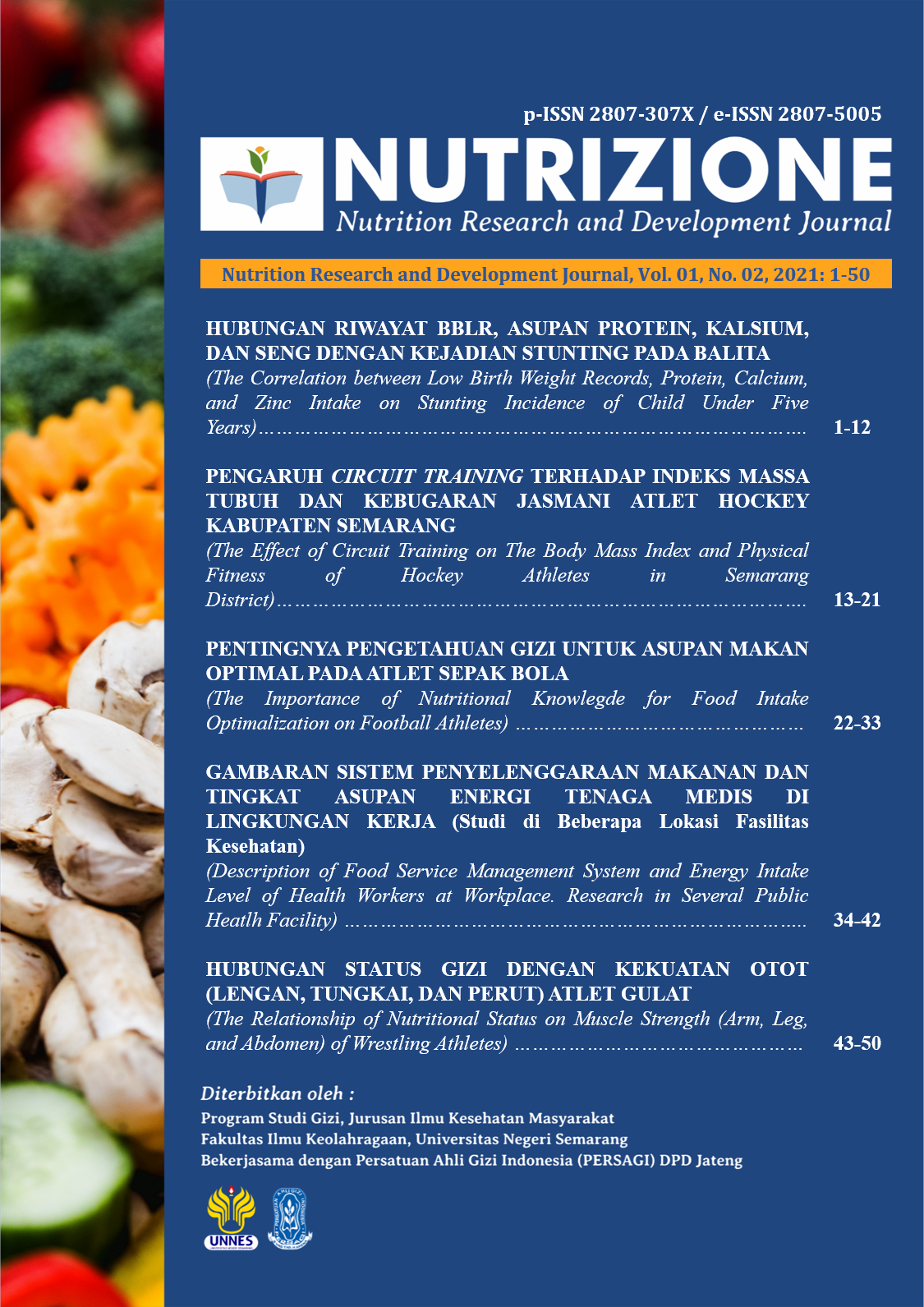HUBUNGAN STATUS GIZI DENGAN KEKUATAN OTOT (LENGAN, TUNGKAI, DAN PERUT) ATLET GULAT
Main Article Content
Abstract
Gulat merupakan salah satu cabang olahraga bela diri (martial arts) yang menitikberatkan pada pengkategorian berat badan. Cabang olahraga ini memerlukan teknik dasar bela diri yang memadai. Adapun teknik tersebut dipengaruhi oleh komposisi tubuh atlet gulat, dimana kemampuan teknik dasar akan menurun karena kurangnya kekuatan otot dan tingginya persentase lemak tubuh. Penelitian ini bertujuan untuk mengkaji hubungan status gizi dengan kekuatan otot (lengan kanan dan kiri, tungkai, dan perut) pada atlet gulat. Penelitian analytical observational dengan rancangan cross-sectional ini dilakukan pada 16 orang atlet gulat KONI Kabupaten Grobogan, Jawa Tengah yang berusia 18-19 tahun melalui teknik total sampling. Subjek penelitian diukur berat badan, tinggi badan, dan persentase lemak tubuh kemudian dihitung status gizi berdasarkan indikator IMT (Indeks Massa Tubuh). Kekuatan otot lengan diukur menggunakan handgrip dynamometer, kekuatan otot tungkai menggunakan back and leg dynamometer, dan kekuatan otot pertu menggunakan metode sit-up selama satu menit. Data dianalisis menggunakan uji korelasi Spearman’s Range Test (CI 95%). Hasil penelitian menujukkan bahwa persentase lemak tubuh tidak berhubungan dengan kekuatan otot lengan, tungkai, dan perut (p=0,361; 0,466; 0,318; dan 0,377), namun IMT menunjukkan adanya hubungan dengan kekuatan otot lengan dan perut (=0,035, r=0.546; p=0,018, r=0,599; p=0,013, r=-0,623). Dapat disimpulkan bahwa status gizi berdasarkan IMT menunjukkan korelasi positif terhadap kekuatan otot lengan (kanan dan kiri) namun berkorelasi negative terhadap kekuatan otot perut.
Article Details
References
Ackland, T.R., Lohman, T.G., Sundgot-Borgen, J., et al. (2012). Current status of body composition assessment in sport: review and position statement on behalf of the ad hoc research working group on body composition health and performance, under the auspices of the I.O.C. Medical Commission. Sports Med, 42: 227.
Fleck, S.J. (1983). Body composition of elite American athletes. Am J Sports Med, 11(6): 398-403
Riyadina, W., & Turana, Y. (2014). Faktor risiko dan komorbiditas migrain. Buletin Penelitian Sistem Kesehatan, 17(4): 371-378.
Shofia, A., Setiawan, D.P., Amin, N., Nilawati, I., & Fadly, S. Hubungan status gizi dengan kekuatan otot lengan atlet bola basket. Nutrizione, 1(1): 1-5.
Jeukendrup, A., & Gleeson, M. (2019). Sport Nutrition 3rd Edition: Normal Ranges of Body Weight and Body Fat. Human Kinetics. Amerika Serikat.
Canda, A. (2017). Top Level Athletes with A Body Mass Index of 30 or Higher. Obesity or Good Muscle Development. Apunts Med Esport., 52 (193): 29-36.
Gacéša, J.P., Barak, O., Jakovljevic, D.K., Klašnja, A., Galić V., Drapšin M., et.al. (2011). Body Mass Index and Body Fat Content in Elite Athletes. Exercise and Quality of Life, 3 (2): 43-48.
Pontaga, L., & Žīdens, J. (2011). Estimation of Body Mass Index in Team Sports Athletes. Lase Journa of Sport Science, 2(2): 33-44.
Dewi, K.I.M., Widiastuti, I.A.E., & Wedayani, A.A.N. (2020). Hubungan antara Indeks Massa Tubuh dengan kekuatan otot pada mahasiswa Fakultas Kedokteran Universitas Mataram. Jurnal Kedokteran, 9(1).
Amin, N., Subiyono, H.S., & Sumartiningsih, S. (2012). Sumbangan power otot tungkai panjang tungkai kekuatan otot perut terhadap grab start. Journal of Sport Sciences and Fitness, 1(2): 8-13.
Syaifuddin. (2006). Anatomi fisiologi untuk mahasiswa keperawatan. EGC. Jakarta.
Brito, C.J., Roas, A.F.C.M., Brito, I.S.S., Marins, J.C.B., Cordova, C., & Franchini, E. (2012). Methods of Body-Mass Reduction by Combat Sport Athletes. Int J. Sport Nutr. Exerc. Metab., 22: 89-97.
Sarkar, S., Debnath, M., Chatterjee, S., Karmakar, N, & Dey, S. (2019). Assessment of nutritional status, body composition parameters & physiological profiles of young male taekwondo and wushu players. Mar. 2019.
Hickner, R., Horswill, C., Welker, J., Scott, J., Roemmich, J., & Costill, D. (1991). Test development for the study of physical performance in wrestlers following weight loss. Int. J. Sport Med., 12(6): 557-562.
Koutedakis, Y., et al. (1994). The effects of two different periods of weight-reduction on selected performance parameters in elite lightweight oarswomen. Int. J. Sports Med., 15(8): 472-477.
Alm, P., & Yu, J.G. (2013). Physicologiacl characters in mixed martial arts. Am. J., Sport. Sci., 1: 12-17.
Mardiana, M., Budiono, I., Lestari, Y.N., Prameswari, G.N. (2019). Relationiship of energy and nutrient on nutritional status of young athletes in Semarang. 5th International Conference on Physical Education, Sport, and Health (ACPES). Advances in Social Science, Education and Humanities Research, 362: 305-309. Atlantic Press.
Kamadi, L. (2019). Hubungan antara kekuatan otot lengan dan keseimbangan dengan kemampuan hand stand dalam senam lantai. SPORTIVE: Journal of Physical Education, Sport and Recreation, 3(1): 63-69.

